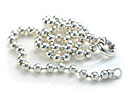KEYWORDS: what is sterling silver jewelry advantages of sterling silver disadvantages of sterling silver care of sterling silver jewelry
 Sterling silver is the standard for beautiful high-quality silver jewelry. It’s 92.5% pure silver, mixed with alloys to add strength and durability. And it won’t wear down, as silver plating can.
Sterling silver is the standard for beautiful high-quality silver jewelry. It’s 92.5% pure silver, mixed with alloys to add strength and durability. And it won’t wear down, as silver plating can.
This guide will help you learn to identify quality in silver jewelry and accessories.
Pure silver, also called fine silver, is relatively soft, very malleable, and easily damaged so it is commonly combined with other metals to produce a more durable product. The most popular of these alloys is sterling silver, which consists of 92.5 percent silver and 7.5 percent copper.
Although any metal can make up the 7.5 percent non-silver portion of sterling, centuries of experimentation have shown copper to be its best companion, improving the metal’s hardness and durability without affecting its beautiful color.
The small amount of copper added to sterling has very little effect on the metal’s value. Instead, the price of the silver item is affected by the labor involved in making the item, the skill of the craftsperson, and the intricacy of the design.
Most high quality silver items are stamped with a “fineness” or “quality” mark. This mark designates the precious metal content of the jewelry, and under federal law, must be accompanied by a maker’s mark or registered trademark.
Because pure silver is so soft, it should only be used when malleability is required, such as in handcrafted jewelry featuring weaving and other intricate designs.
Sterling silver is most often used for jewelry and household accessories because of its combination of beauty and durability. Acceptable quality marks for sterling silver include:
- sterling
- sterling silver
- ster
- .925
With proper care, your fine quality silver will last a lifetime. To minimize scratches and other damage, store your silver jewelry either in a cloth pouch or in a separate compartment in your jewelry box.
Avoid exposing your silver to household chemicals when cleaning with bleach or ammonia, or when swimming in chlorinated water, as these chemicals can damage silver.
Care should also be taken to prevent silver tarnish build-up, a dulling that naturally occurs when silver reacts with sulfur or hydrogen sulfide in the ambient air. Keeping your silver inside a cloth pouch reduces its exposure to the air, thus slowing the build-up of tarnish.
To clean your silver, use polishes formulated specifically to remove tarnish. You can find fine silver polishes, solutions, or cloths appropriate to remove tarnish at most jewelry stores or specialty craft stores.
If your sterling silver jewelry also contains stones, avoid the kind of tarnish remover where you immerse the entire jewelry piece in the liquid to soak, as this can damage the finish on some stones and dull them.
A product that works well for us is the Silver Polishing cloth sold by Walmart. It’s inexpensive, lasts for a long time, and is already pre-treated with a tarnish remover on one side, and has a soft cloth for final polishing without scratching on the other side. The Walmart polishing cloth I’m talking about comes in a red box, is usually located on an end-cap display located over by the watches, and costs around $5.00. When the cloth becomes visibly dirty, you should throw it away and buy a new one, since dirt can scratch your silver jewelry.
Tarnish is most easily removed when it first becomes visible.
Although wearing your silver jewelry often is the best way to prevent tarnish from building up, regular cleanings of all your silver items will prevent tarnish and keep your silver bright and sparkling. The need for regular polishing is the only disadvantage to sterling silver (german or nickel silver does not tarnish as quickly), but polishing your sterling silver is not a hard job if you do it regularly before the tarnish builds up too heavily.
If you leave tarnish on your sterling silver for too long, it can damage the silver permanently, or at least make it a real chore to remove. Wipe your sterling silver down with a polishing cloth after handling it, or before you put it away. The oils from your hands make tarnish build up faster, and can pit the silver over time.
Look for the fineness mark and the maker’s mark on the underside of the silver item you are considering buying to ensure the quality.
Navaho Native Americans are credited with being fine silversmiths. Learn more about Native
Americans long history in sterling
silver jewelry production. There is so much Native American history to
uncover.